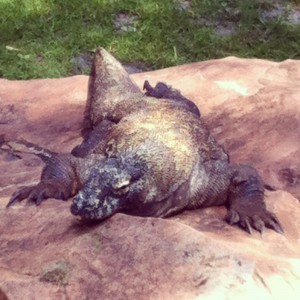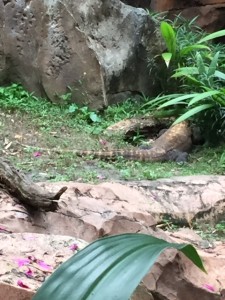I’m not certain I can adequately explain my fascination with Animal Kingdom’s Komodo dragon. I don’t consider myself a person with a general fondness for reptiles (although snakes and lizards don’t bother me like they do some other people). That dragon though! I make a point of visiting him every time I’m on the Maharajah Jungle Trek. He’s even become the official mascot of the Disney Exchange Podcast (although Nick and Dave do NOT understand my adoration for such a “boring” animal). Today I thought I’d share with you some of the amazing Komodo Dragon (Varanus komodoensis) facts that have me so thrilled…
- Komodo dragons are enormous! They are the world’s largest living lizard and have been around for nearly 4 million years. During their approximately 30-year lifespan, Komodo dragons can grow up to 10 feet in length and weigh up to 300 pounds. If you’re lucky enough to see one move (they do tend to remain very still for long periods of time) – they’re fascinating to watch! And we don’t have to go all the way to their native islands of Indonesia – we can see a beautiful specimen at Walt Disney World!
- Komodo dragons are amazing hunters! Beyond being carnivores, Komodo dragons are not picky eaters. They’ll eat just about any kind of meat they come across, dead or alive. Waiting along game trails, Komodo dragons in the wild will attack live prey (their favorite is deer) and may be lucky enough to use tooth and claw for an instant meal. If their prey does manage to escape, the dragon will patiently follow…waiting for its poisonous saliva to slowly kill their dinner! Come on! That is the coolest thing EVER! Sure it’s gross, but also very amazing. Also interesting: Komodo dragons are immune to the poisonous saliva when they bite each other. See this picture? He’s not being shy, he’s in stealthy hunter mode!

- They have an incredible sense of smell. Like a snake, the Komodo dragon’s forked tongue gathers scent from the air and processes that information via the Jacobson’s organs on the roof of their mouth. If the scent being analyzed is stronger on one fork of the tongue, the dragon knows which direction to go. When Komodo dragons walk, they swing their heads from side to side in order to better pick up smells in the air.
- They come from humble beginnings. Komodo dragon moms lay approximately 30 eggs in September. The eggs incubate under the female dragon’s protection for 9 months after which the hatchlings are on their own. At about a foot-and-a-half in length and just 3.5 ounces, the baby dragons must fend for themselves on a diet of snakes, birds, insects, and lizards while avoiding being killed by larger animals including other Komodo Dragons.
- The Komodo dragon is a vulnerable species. Illegal poaching combined with human encroachment into the dragons’ limited natural habitat have taken a toll on wild population numbers. With only 4000-5000 dragons remaining worldwide, conservation efforts are being made on a variety of fronts. Unfortunately, Komodo dragons in captivity are easily susceptible to infection and disease. Indonesia’s Komodo Dragon National Park has been making strides in stabilizing this species’ population and ensuring the dragon’s long term survival. (You can read about those efforts here.)
Are you still with me? Thanks for hanging in! Are you by any chance a fellow Komodo dragon fan? How about Disney’s Animal Kingdom? What’s your favorite animal there?

I too am a big fan of the Komodo dragon. I also love to hang out at the bat cave. Okay, it isn’t really a cave but I love the bats.
And the tigers.
And the porcupine.
I think the porcupine is gone now (from what I’ve heard). I love the bats too!!! The giant leathery wings are fascinating! On occasion when we catch the tigers awake, I love to watch them- otherwise they may as well be fur rugs.